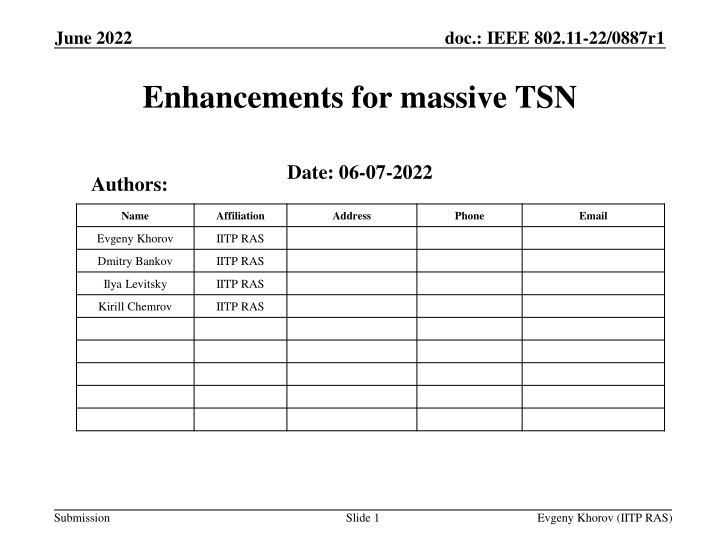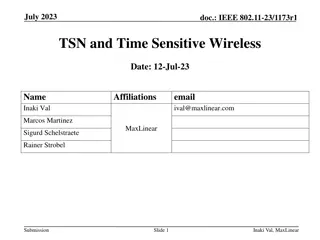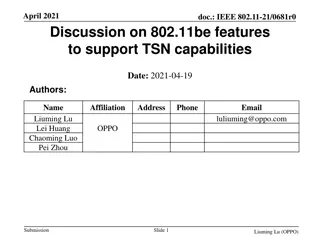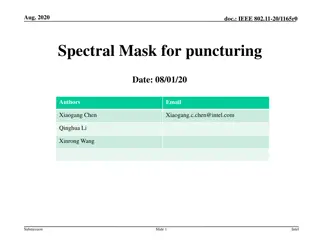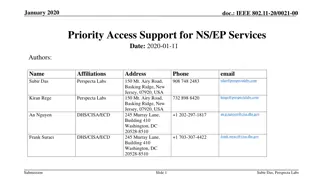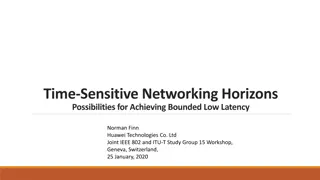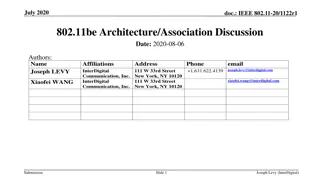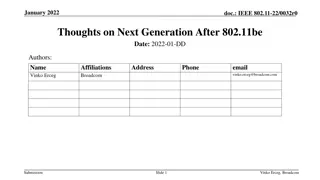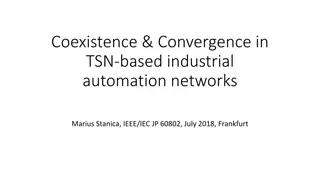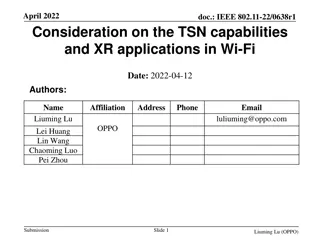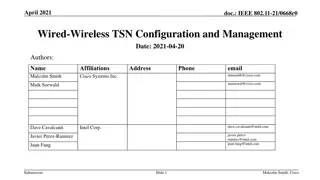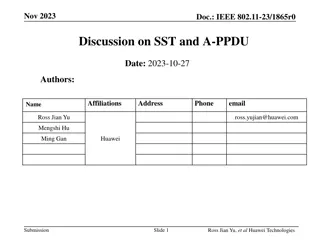Enhancements for Massive TSN in IEEE 802.11be
Enhancements for Massive Time Sensitive Networks (TSN) in IEEE 802.11be focus on improving integration with heterogeneous Ethernet and Wireless LANs, enhancing throughput, reducing latency, and ensuring competitiveness for IEEE Std. 802.11 in the upcoming years. This document discusses the challenges and potential solutions related to TSN support in 802.11be, particularly addressing issues such as real-time transmission capabilities, industrial automation applications, reliability, packet sizes, delays, and overhead considerations.
Download Presentation

Please find below an Image/Link to download the presentation.
The content on the website is provided AS IS for your information and personal use only. It may not be sold, licensed, or shared on other websites without obtaining consent from the author.If you encounter any issues during the download, it is possible that the publisher has removed the file from their server.
You are allowed to download the files provided on this website for personal or commercial use, subject to the condition that they are used lawfully. All files are the property of their respective owners.
The content on the website is provided AS IS for your information and personal use only. It may not be sold, licensed, or shared on other websites without obtaining consent from the author.
E N D
Presentation Transcript
June 2022 doc.: IEEE 802.11-22/0887r1 Enhancements for massive TSN Date: 06-07-2022 Authors: Name Affiliation Address Phone Email Evgeny Khorov IITP RAS Dmitry Bankov IITP RAS Ilya Levitsky IITP RAS Kirill Chemrov IITP RAS Submission Slide 1 Evgeny Khorov (IITP RAS)
June 2022 doc.: IEEE 802.11-22/0887r1 TSN with 802.11be According to PAR: Users expect improved integration with Time Sensitive Networks (TSN) to support applications over heterogeneous Ethernet and Wireless LANs. This amendment aims to build on the current and emerging WLAN technologies by providing further improvement of aggregate throughput and latency to ensure competitiveness of IEEE Std 802.11 in coming years. Does 11be really support integration with TSN? The main feature of 802.11be for TSN is RTWT, Initially designed for low-power operation Requires auxiliary mechanisms to work with legacy devices Optional support Too heavy and not suitable for massive real-time transmissions of short packets Submission Slide 2 Evgeny Khorov (IITP RAS)
June 2022 doc.: IEEE 802.11-22/0887r1 Industrial Automation is a killer APP for TSN High Reliability: 0.99..9 Short packets: 10s of bytes Dozens of STAs connected to an AP Low delays: <1ms No Jitter: <10us Although 5G targets 1ms delays, by now, it is not able to satisfy these requirements because of design limitations, but Wi-Fi has no such drawbacks Submission 3 Evgeny Khorov (IITP RAS)
June 2022 doc.: IEEE 802.11-22/0887r1 Current Status in 802.11be Many solutions proposed are left out of consideration or optional, which complicates support of industrial internet applications and guaranties in delays High time granularity of channel reservation mechanism (e.g., Quiet Element: 1 ms) is not efficient for short packet transmission The overhead to transmit a short packet is huge. At least SIFS+Preamble+MAC header+CRC The headers in new standards are long 802.11ah designed a short packet format (PV1), but it works only in S1G with long timing. 10 byte (in UL & DL) per device per cycle Video 5Mbps each AP 100 sensors Mac overhead = 34+10 byte (including QoS+HT) = 45.3+13.3 us = 64us @MCS5 (6 Mbps in 26 tone) PHY + Protocol overhead = 40 us (Preamble) + TF +ACK + 2 SIFS + DIFS >106us+TF+Multi STA BA Effective rate in UL = 370 bytes per >250 us = 12Mbps in 80MHz channel @MCS5 (too low!) Submission 4 Evgeny Khorov (IITP RAS)
June 2022 doc.: IEEE 802.11-22/0887r1 Example Existing approaches 16 16 16 16 16 16 16 200 200 200 200 200 200 MU- 1 380us CTS RTS DL DATA UL DATA DL DATA UL DATA DL DATA UL DATA The approach proposed in this submission 16 16 16 2 2 104 88 88 88 IRTS 468 us CTS DATA ACK+DATA (x3) *MCS3 Submission 5 Evgeny Khorov (IITP RAS)
June 2022 doc.: IEEE 802.11-22/0887r1 Key Ideas For repetitive traffic patterns, we can avoid the same repeating overhead in procedures Introduce I-TXOP during which special short frames are only transmitted with scheduled access Squeeze overhead by removing useless headers and repetitive information, i.e., send repetitive information only once Short or removed interframe space IMPDU as a type for aggregation for multiple receivers within a common codeword Observation: Industrial Wi-Fi does not need MU-MIMO and DL OFDMA Submission 6 Evgeny Khorov (IITP RAS)
June 2022 doc.: IEEE 802.11-22/0887r1 A possible scheme for industrial frame exchange Legacy operations Legacy operations I-TXOP . I-TXOP . Industrial-TXOP . 0 xIFS <SIFS IMPDU IMPDU IMPDU IMPDU SIFS IRTS IMPDU IMPDU IMPDU IMPDU CTS NAV . MAC Header Data + Check Sum PHY HEADER Submission 7 Evgeny Khorov (IITP RAS)
June 2022 doc.: IEEE 802.11-22/0887r1 IMPDU format Header Payload FCS Header Payload FCS Octets: 2 Length 4 2 Length 4 The header contains only Sequence Number (12 bits) Immediate ACK bit (1 bit) acknowledges the reception of the previous frame scheduled for the STA Reserved (3 bits) RX address, TX address, the number of MPDU within IMPDU are determined by the schedule Submission 8 Evgeny Khorov (IITP RAS)
doc.: IEEE 802.11-22/0887r1 Schedule A list mapping an offset time to a scheduled frame info Offset time is measured from the end of CTS (or the end of the previous schedule if several schedules are used within ITXOP) The schedule can be sent via the IRTS frames. Schedule Frame #0 Frame #1 Frame #n Frame info Frame info Frame info Offset Offset Offset Octets: 2 variable 2 variable 2 variable Submission Evgeny Khorov (IITP RAS) 9
June 2022 doc.: IEEE 802.11-22/0887r1 Example of using a schedule The schedule is broadcasted via IRTS frames. Schedule #1 Offset #0 Frame #0 Offset #1 Frame #1 Offset #2 Frame #2 Offset #3 Frame #3 Offset #4 Frame #4 ( BA for multiple sensors) (destined for multiple sensors) Schedule #1 IMPDU IMPDU SIFS SIFS IRTS SIFS SIFS IMPDU IMPDU IMPDU IMPDU CTS Frame #0 offset NAV . Frame #1 offset Submission 10 Evgeny Khorov (IITP RAS)
June 2022 doc.: IEEE 802.11-22/0887r1 Scheduled frame info template Let us try to reuse User info field of the Trigger frame Used only for OFDMA MU Not used Only N_SS Not used Submission 11 Evgeny Khorov (IITP RAS)
June 2022 doc.: IEEE 802.11-22/0887r1 Scheduled Frame Info Data, Data+ACK, BlockAck, etc. Octets DL Number Of User Fields RX AID12 RX AID12 N of SS Type Length Type Length DL=1 MCS FEC 1 7 3 4 1 12 4 16 12 4 16 Bits: A per user info may repeat multiple times (with the same RU Allocation) to signal that multiple MPDUs for the receiver are present. common per user 16 32 UL UL Target Receive power (TBD) UL Target Receive power (TBD) Number Of User Fields RX AID12 TX RX AID12 TX *RU DL=0 Type MCS Length N of SS FEC FEC Allocation AID12 AID12 1 7 12 12 4 4 8 16 3 1 4 12 12 1 4 Bits: 8 64 *For RU Allocation see Table 9-29i 802.11ax D8.0 Note 1: for Groupcast frames, Groupcast AIDs are needed Submission 12 Evgeny Khorov (IITP RAS)
June 2022 doc.: IEEE 802.11-22/0887r1 Schedule broadcast in beacons The schedule is broadcasted via beacons. A beacon has one or several Schedule IEs, each containing one schedule. Element ID Length Schedule Info Schedule ID can be from 1 to 127 Schedule ID = 0 is used for ad hoc schedule Octets: 1 1 variable Schedule ID 1 Duration Schedule Octets: 2 variable Submission 13 Evgeny Khorov (IITP RAS)
June 2022 doc.: IEEE 802.11-22/0887r1 IRTS frame format The schedule can be sent in IRTS. It is a Control frame Frame Control 2 Tetrapartial Timestamp 4 Address 1 Address 2 Schedule FCS Duration/ID Octets: 2 6 6 variable 4 As for 802.11be, there are three Control Subtypes left: 0000, 0001, 1111. Address 1 is a group address of multiple sensors that will response to IRTS with a synchronous CTS. Address 2 is the address of the STA sending the IRTS (we assume that IRTS are sent by the AP) Tetrapartial Timestamp is included for synchronization Tetrapartial Timestamp field contains the value of the 4 least significant octets of the STA s TSF timer at the time that the start of the data symbol containing the first bit of the Tetrapartial Timestamp field appears at the transmit antenna connector. Tetrapartial Timestamp inspired by 802.11-2020, 9.8.4.2 STACK frame format Submission 14 Evgeny Khorov (IITP RAS)
June 2022 doc.: IEEE 802.11-22/0887r1 IRTS (cont d) IRTS triggers one or several schedules defined in beacons (so the AP can combine multiple schedules in one TXOP) IRTS can still define an ad hoc schedule (ID = 0), which will not be stored for future. IRTS can also define a new schedule (with ID>0) on the fly It is useful if the AP needs to update a schedule before the next beacon, and then to reuse it Schedule Info list variable Frame Control 2 Tetrapartial Timestamp 4 Address 1 Address 2 FCS Duration/ID Octets: 2 6 6 4 The IRTS frame format contains Schedule Info. If Schedule Present is 1 If Schedule ID is 0, the schedule is ad hoc Otherwise, the schedule shall be remembered If Schedule Present is 0 Schedule ID shall contain a valid identifier The Duration and Schedule field are absent Schedule Info Schedule Info Schedule Info Schedule Present + ID 1 Duration Schedule Octets: 0 or 2 variable Schedule ID 7 Schedule Present Bits: 1 Submission 15 Evgeny Khorov (IITP RAS)
June 2022 doc.: IEEE 802.11-22/0887r1 Example of Multiple schedules in one TXOP Schedule #1 Schedule #1 Frame #0 Frame #1 Frame #2 Frame #3 Frame #4 Frame #0 Frame #1 Frame #2 Frame #3 Frame #4 Schedule #1, #1 IRTS CTS NAV . Submission 16 Evgeny Khorov (IITP RAS)
June 2022 doc.: IEEE 802.11-22/0887r1 Summary In case of quasi-periodic traffic of multiple STAs We do not need to start every UL MU TXOP with full TF (the TF can be compressed as all parameters are exchanged in advance) We do not need to have full PHY and MAC headers of the frames More flexible packet/frame aggregation Shorter interframe spaces thanks to no need to wait for the end of the frame Submission 17 Evgeny Khorov (IITP RAS)
June 2022 doc.: IEEE 802.11-22/0887r1 Straw Poll Do you agree that the support of Industrial TSN Applications for multiple STAs shall be provided by Further TGbe activities More Discussion within WNG Need more info Abstain Submission 18 Evgeny Khorov (IITP RAS)
